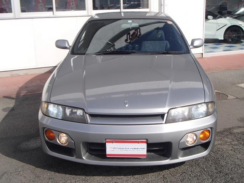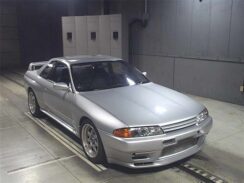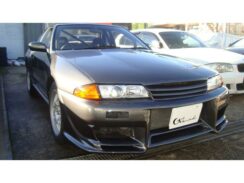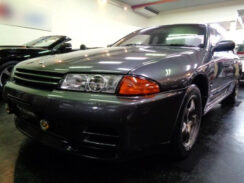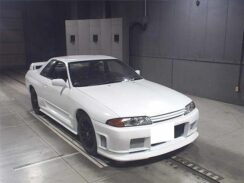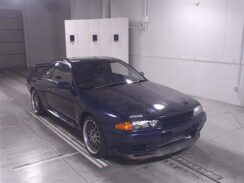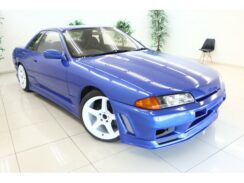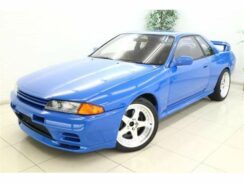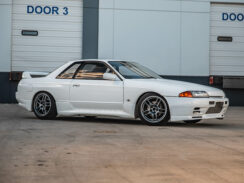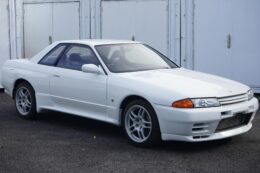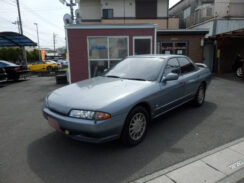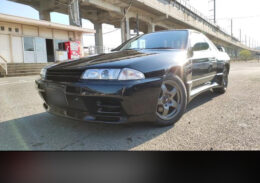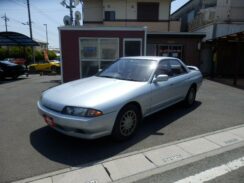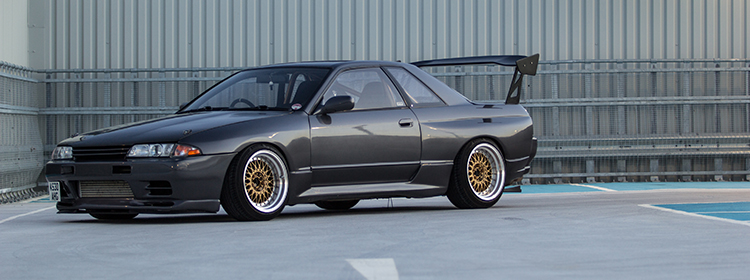Nissan Skyline R32 Buying Guide
The Nissan Skyline R32 was introduced during the final stage of the R31 production back in 1989. It was produced when motor vehicle companies in Japan were making full financial recoveries and doing well enough to compete in races. They introduced the E-BNR32 chassis for Nissan, designed for a more competitive racing vehicle that was better than their previous GTS-R. Later on, the GT-R badge was revived on the R32 after 16 years of disappearance in the skyline series. To save money Nissan dropped all body styles for the R32 except the 2-door coupe and the 4-door sedan body styles.
Nissan still maintained the RB series engines on the R32 Skyline, and one 1.8 -litre CA engine was used. CA engines were 4-cylinder engines also manufactured by Nissan. All RB series engines were put in every variation of the R32 Skyline and underwent improvements over the previous ones in last-generation skylines.
Nissan removed the twelve-port inlet; thus, the heads were improved. The fuel injection system was upgraded to an electronically concentrated control system (ECSS). Some versions of the R32 Skyline had rear-wheel steering, with the rear wheels being hydraulically connected to the steering wheel. This four-wheel steering system (HICAS) was first introduced in the R32 and then improved over time with the R33 and R34 Skylines.
Nissan’s four-wheel-drive system, the ATTESA E-TS, was used on some basic trims of the R32, such as the GTS-4, also called the GTS-T type M. The R32 Skyline also used a four-link suspension system. All these upgrades over the previous generation skylines made the R32 better in all ways. Either as a daily driver or a sportier family car.
A 5-speed automatic transmission was also available for the R32. The R32 GTS-25 was one of the first cars in the skyline series and Japan to have a 5-speed automatic transmission.
Nissan made numerous Skyline R32 trims, including M-spec versions that had better brakes and larger wheels. Later on, the M-spec trim was only available for the R33 and R34 Skylines. ABS was also introduced in the R32 and was optional for some trim levels.
All turbo models of the R32 Nissan Skyline had a viscous limited-slip differential that came standard, and a mechanical limited-slip differential for all GT-R models.
In Japan, the engine displacement sizes of your engine determine the amount of road tax a car owner has to pay. The larger the displacement, the more the tax. Nissan offered the 1.8-liter CA engine and the RB20 engine to customers who could not pay hefty annual road tax.
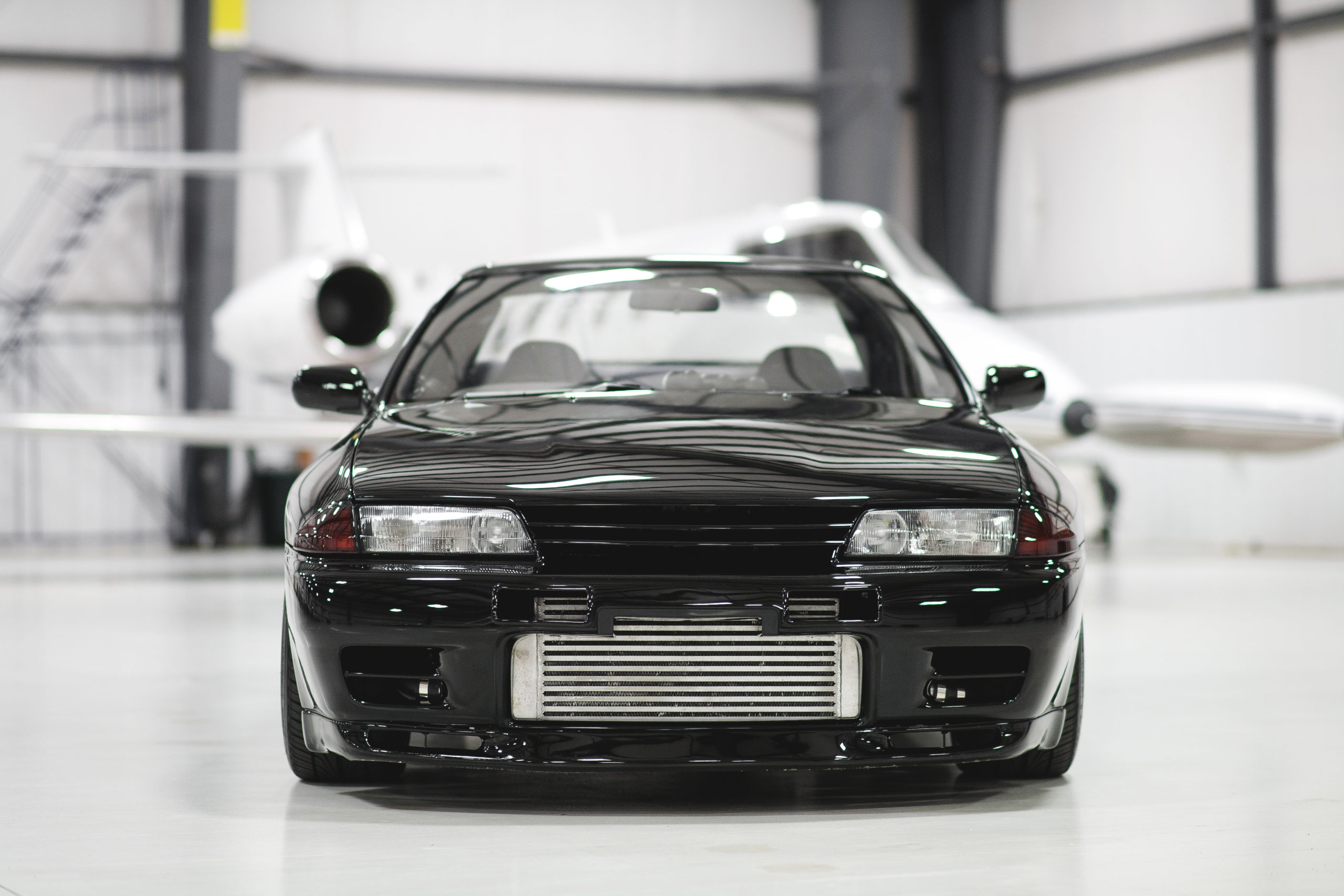
The R32 Nissan Skyline was also considered a compact car under Japanese laws. These laws determined the amount of tax liability based on the exterior dimensions of the car. For larger vehicles such as station wagons, the tax liability was high. Nissan discontinued skyline wagon versions until they started producing the R33 in 1996. That is why most people prefer the 1996 Nissan Stagea as an R33 wagon.
3 months after Nissan started production of the R32 Skyline, they introduced a GT-R spec for the R32. But Nissan had made a prototype R32 GT-R in 1988, which had the RB26DETT engine, and when it went into production in 1989, nothing was changed. Nissan wanted a race-bred R32 that would replace the R31 GTS-R in group A racing.
Nissan first tested out a bored and stroked RB20 engine for racing models, which increased the engine displacement to 2.4 litres with a power output of 310 horsepower. The engine was also turbocharged, and the racing regulations put it in the 4.0-litre class. Later, Nissan decided to make their racing R32s all-wheel drive, but this increased the weight, and the cars could not compete effectively in the 4.0-litre class.
Nissan then decided to increase the engine’s displacement to 2.6-liter (RB26DETT), which allowed them to move up to the 4.5-litre class. In this class, they could compete effectively with a better engine and similar weight as other competitors.
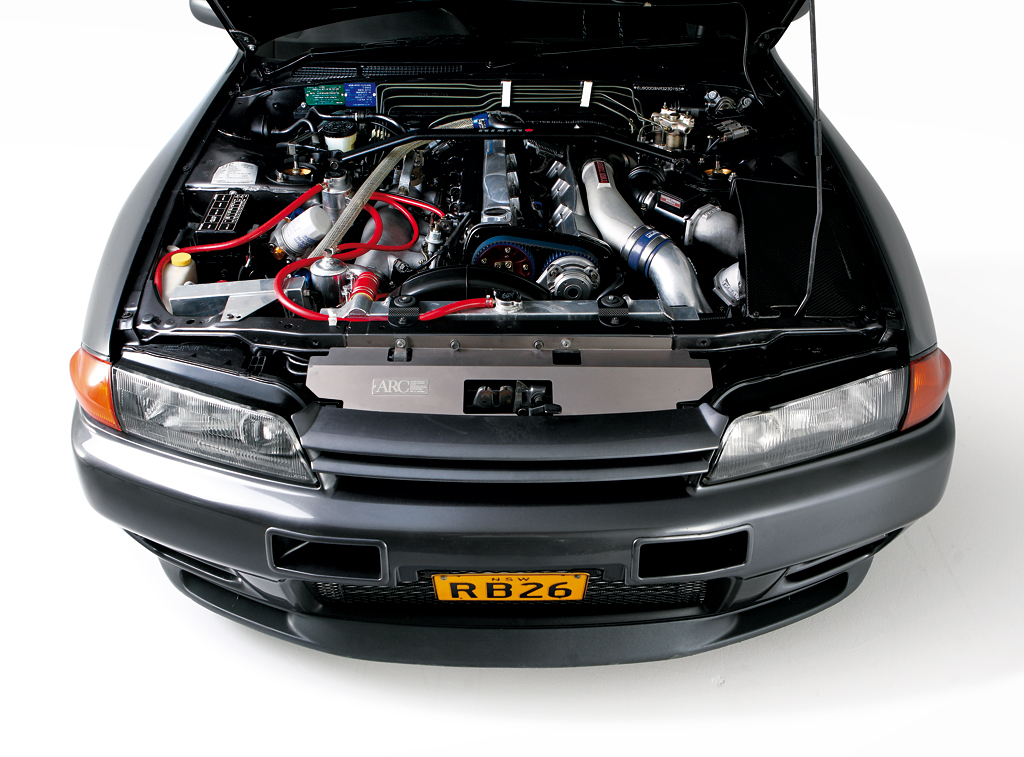
The RB26DETT could make around 500 horsepower racing R32s, but it only made 275 horsepower for the consumer market. This was because of the Gentlemen’s agreement among Japanese car manufacturers at the time. However, the power output was at around 310 horsepower, but Nissan stated 275 horsepower. This was something other manufacturers were doing. Still, it was ignored silently to prevent arguments and disagreements among car manufacturers.
The R32 GT-R had wider bumper vents which increased airflow and made the car more aerodynamic. Performance upgrades over the base trim R32 included a larger intercooler, larger brakes, and better tires. Weight reduction was also made by replacing the stock hood and front guard with aluminum-made ones. The rear and front-wheel arches were also flared, making the R32 GT-R wider than the base trim R32.
The soft fabric seats were replaced with sportier, more supportive seats with shoulder padding for the interior. R32 GT-Rs had a torque meter that replaced the digital clock. The turbo boost gauge was moved to above the climate control, and oil temperature and voltage gauges were added.
Nismo, (Nissan motorsports) made a Nismo version of the R32 GT-R. These had the racing spec RB26DETT engines, but power output was reduced to 310 horsepower. The power output was reduced by muzzling the exhaust system, restricting the boot, and restricting the ECU system.
Then Nissan continued to make a V-spec version of the GT-R in 1993. The R32 V-spec GT-R was produced after the racing rules allowed manufacturers to have 17-inch wheels as the 16-inch wheels limited the size of the brakes. The brakes that Nissan used on the R32 GT-R were not that good, and with 17-inch tires, they could install better brakes.
The R32 GT-R V-spec had 17-inch BBS wheels, with larger Brembo brakes. Clutch actuation was changed from a push to pull system. This increased transmission efficiency and had a lighter pedal manipulation. Shifting between gears was smooth as the force for the pull system is less than the force for the push system. Later on, the R32 GT-R V-spec 2 was released with wider vents and wider tires.
Read our full Nissan Skyline Buying Guide
View R32 Nissan Skylines For Sale
R32 Nissan Skyline Models
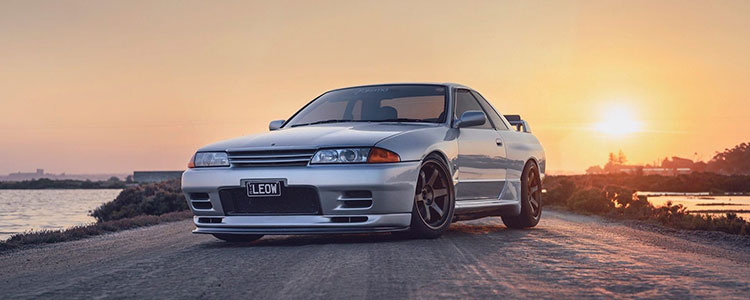
R32 GXi
This was the more basic R32, it came with a 1.8-litre SOHC CA engine with a power output of 90 horsepower and 105 lb.-ft. It was only available as a four-door sedan and was rear-wheel drive only.
R32 GTE
This version of the R32 was also only available as a four-door sedan. Other trims under the R32 GTE, such as the R32 Type X and the R32 SV. These were rear-wheel-drive only and had the RB20E SOHC engine putting out 125 horsepower and 110 lb.-ft.
R32 GTS
Like the R32 GTE, this trim also had other sub-variants. The R32 GTS had the R32 GTS SV, the R32 GTS type X, and the R32 GTS urban road. All these had the RB20DE DOHC engine with similar power output and were rear-wheel-drive. The upgraded RB20DE engine in the R32 GTS made 153 horsepower and 114 lb.-ft.
There was also a four-wheel-drive version of the R32 GTS, which was equipped with super HICAS; Nissan’s rear-wheel steering system. All versions of the R32 GTS were available as either a four-door sedan or a two-door coupe.
R32 GTS-T
The R32 GTS-T had two sub-variants, the R32 GTS-T Type M and the R32 GTS-4. Both had the RB20DET DOHC engine pushing 212 horsepower and 195 lb.-ft. The R32 GTS-T and the R32 GTS-T type M were equipped with super HICAS as standard and were both rear-wheel drive.
The R32 GTS-4 was an all-wheel-drive also with super HICAS.
You could get the R32 GTS-T either as a two-door coupe or a four-door sedan.
R32 GTS-25
This variant came with the RB25DE DOHC engine pushing 175 horsepower and 170 lb.-ft. It came as either a two-door coupe or a four-door sedan. A type X model for this variant was also made, and both came as rear-wheel drive.
Nissan made an R32 GTS-25 with super HICAS called the R32 GTS-25 type S that came with a similar engine and body configuration as the base trim R32 GTS-25.
Later on, Autech took the GTS-25 and put an RB26DE DOHC engine. The RB26DE engine had a power output of 217 horsepower and 205 lb.-ft. Like the GTS-25 type S, it had an all-wheel-drive with super HICAS. Only 201 of these were made, and all came with a 5-speed automatic transmission.
R32 Nissan Skyline GT-R Models
R32 Skyline GTR
This R32 GT-R base trim came with the RB26DETT engine making around 275 horsepower and 260lb.-ft. The turbos on the RB26DETT engine had ceramic turbos.
R32 Skyline GT-R V-SPEC
Nissan made a V-spec (Victory Specification) R-32 GT-R to celebrate their success in racing. It had an aluminum hood and 17-inch wheels, which replaced the 16-inch wheels of the base R32 GT-R. 1,396 units of the R32 GT-R V-spec were made. It had the same engine as the R32 GT-R with steel turbine turbos.
RR32 Skyline GT-R V-SPEC II
The only change the R32 GT-R V-spec II had over the R32 GT-R V-spec is wider tires for more grip. Only 1,306 units of this trim were made.
R32 Skyline GTR NISMO
This was tuned and refined by NISMO to make a street-legal car. It had the same RB26DETT engine from the racing spec R32s, but its power output was the same as the standard R32 GT-R. It was stripped of unnecessary equipment such as air conditioning and radios to reduce the weight making it as aerodynamic as possible. Only 560 of these were produced, and 60 were used by Nissan for group A racing. ABS system was also not available for the R32 GT-R Nismo as it was illegal in group A racing.
R32 GTR N1 AND N2
These were designed for use in Japan’s N1 racing category. The engine was upgraded to N1 specifications. The car was made as lightweight as possible, so Nissan removed the rear wiper, trunk carpet, air conditioning, and stereo system. There were also V-spec versions of the R32 GT-R N1, known as the GT-R V-spec N II. All N badged R-32 GT-Rs had to be reinforced to the brake master cylinder and brake cooling ducts underneath. Only 245 units of the N-spec R32 GT-Rs were made.
Aftermarket Spec Tuned R32s
Tuning companies such as Tommy Kaira and HKS also made their versions of the R32 Skyline.
Tommy Kaira
Tommy Kaira first made the M20 which was made from the GTS-T coupe. They tuned the RB20DET engine, and it produced around 245 horsepower with 203lb.-ft. They also made the M30 from the same GTS-T coupe, but it had a tuned RB30DE making about 275 horsepower and 220lb.-ft.
When the R32-GTR debuted, Tommy Kaira also made their version tuning the RB26DETT, taking it to around 350 horsepower and 260 lb.-ft. This version was known as the Tommy Kaira-R. Both the M20 and M30 were rear-wheel drive, and the Tommy Kaira R was all-wheel drive with super HICAS.
HKS
The first tuned R32 from HKS was the HKS EN2-A which was based on the GTS-T coupe. The tuned RB20DET made around 345 horsepower. The HKS EN2-A was also rear-wheel drive with super HICAS.
HKS, later on, made the HKS ZERO-R based on the R-32 GT-R. The RB26DETT was broad and stroked to 2.7 litres, pushing around 450 horsepower and 360 lb.-ft. Then in 2006, the HKS ZERO-R was updated. The engine was broad and stroked and thus increasing the engine displacement to 2.8 litres. The updated engine made around 600 horsepower and 480 lb.-ft. The HKS ZERO-R was an all-wheel drive with super HICAS.
Common Issues with the R32 Skyline
- Oil pump failure was a common issue among skylines with the RB engines. The inefficient oil pump in these engines was poor for the turbocharged versions. When you hear engine noises coming from the engine bay, and everything else checks out to be okay, it’s most likely the oil pump. Replacing the oil pump is an easy solution to this.
- Spinning out when cornering roads mostly happened to rear-wheel-drive skylines without super HICAS. However, if you tune the engine to make more power, the rear end will probably spin out on you when cornering. You’ll need better tires to solve this or if you have the funds, turn it into all-wheel drive.
- Chassis and body rust is a common issue with cars from the pre-90s. Rust occurs underneath, on the body panels. Suppose the vehicle was used for racing or has high mileage. In that case, the chassis has most likely flexed if the car was not maintained properly. Chassis and body weakness was one of Nissan’s weak points.
- Nissan focused so much on the R32’s performance and paid less attention to the interior. Nothing was wrong with the interior as nothing was spoiled. But with time, the gauges read wrongly, and the dashboard faded.
- Loss of power due to coil pack failure was also an issue, especially with the turbocharged engines. Replacing the stock coil packs fixes this issue.
- Nissan did not install airbags for the driver and passenger in their skylines until 1996. That is why the R32 and some versions of the R33 Skyline were banned from importation in certain countries.
Guide to Purchasing an R32 Skyline
R32 Nissan Skyline’s, like other old cars, most likely have rust underneath, on door hinges or the body panels. Make sure to check for rust around the car, ensuring you do not miss a spot. If the vehicle has been repainted, feel the paint with your fingers. If there are bumps, you have some questions to ask. Rust under the paint could eat into the body panels, leading to expensive repairs or replacing the rust component. If the body panels appear repainted, ask the owner why and when was the repaint done.
The frame of the R32 is known to flex with time due to weaknesses. Stand approximately ten feet away and check the structural integrity of the car from an angle. You can also check the body panel alignment and the space between the body panels. Flex in the frame will make the vehicle look bent, especially in the middle.
Once you have verified the car’s structural integrity, proceed to check the engine bay and the suspension. Check for leaking fluids in the engine bay and do this with the engine running. Rev the engine and listen for any strange noises coming from the engine bay. For the suspension, sway the car from the rear and the front and listen for creaks. You can also check the condition of the suspension from underneath.
Take the car for a test drive, feel the transmission between gears and pay attention to the transmission. Drive the vehicle over bumps and feel the suspension. If the car slowly accelerates, there’s an issue with the fuel or air filters or it might be something else slowing down the engine’s combustion. But this is something that can be sorted if the seller knows what is causing the slow acceleration. Some sellers reduce the price of the vehicle for the cost of replacement or fixing the car if you find any issues.
Ask for a service record. Most car owners keep this to reassure the buyer of the condition of the car. If there is none, ask a certified mechanic to do a proper car check for you if you can’t do it for yourself.
Check the condition of the interior; skylines have badged seats and carpets. You rarely find the original interior components. In most cases, you find an upgraded interior which tends to be better than the stock interior.
If you are a person who prefers authenticity, check the type of engine, brakes, rim size, and relevant badging that proves the R32 you are buying is an actual R32 skyline. Running the VIN on an appropriate website provides you with everything you need to know about the car. If the search results differ from what is in the car, you have to double-check with the owner.
Lastly, you have to check the paperwork. This is the seller’s proof of ownership. Failure to provide one can be a red flag, and you should back away from the deal. Suppose the owner cannot prove ownership by showing the relevant paperwork. In that case, they have to have a legal way to prove ownership.
Once everything checks out, you can open a dialogue for negotiations. Remember that there is always a ready market for skylines, so pitch a relevant price to the seller. If you bid too low, the seller will reject your bid without even negotiating. Also, do some research on the market price and then compare it with the car’s condition. If the buyer asks too high for the car, try to bring the price down to what you have in mind or even lower.
Pros and Cons of Owning an R32 Skyline
Pros
- R32 Nissan Skylines are reliable daily drivers, especially if you find one well-maintained with a stock engine.
- Reliable powerhouses. RB series engines are very tunable, with little work you can have a better car than most that are out on the street today. You can manage a light tune without affecting the reliability of the engine. If you want more power output, the reliability will be reduced. It will cost more depending on the power output you are aiming for.
- R32 Skylines can do with minimal engine tuning as they are lightweight. Some owners prefer doing this to keep the car as authentic as possible. This increases the price of the R32 with time.
- Skylines go up in price when you maintain them properly. If you choose to buy one, you are making an investment that you should care for. The price goes higher even quicker if you get yourself a rare spec R32 skyline.
- Status. Having one of the most iconic JDM cars earns one that sweet spot in the car community.
- The R32 Skyline is also a beauty even without cosmetic mods. Everywhere you go, you will notice heads turning and people taking out their phones to take photos of your car.
Cons
- 2-door coupes lack cabin space. If you are a family person with an R32 coupe, you might need another car for family use.
- High insurance and maintenance costs. A skyline is an ever-increasing asset, and to get insurance for such assets, you have to pay high insurance costs.
- Skylines are old vehicles, so issues will always arise. When they do, the cost of fixing a part or replacing it is not cheap, depending on the degree of damage and what part requires repair.
FAQ
Nissan Skyline R32 sedans are priced at approximately $12,000, but if you want a coupe, you should budget around $20,000. Prices for high-spec models such as the R32 GTST start at around $30,000, while R32 GTRs go for at least $45,000.
Production of the Nissan Skyline R32 started in 1988 for prototype cars. The GT-R badged also returned in the same year, 15 years after the Nissan Skyline KPGC110 GT-R was produced in 1973. Official production started in 1989.
Official production of the Nissan Skyline began in1989 and ended in 1993. However, the production of the Nissan Skyline R32 GT-R ended in 1994.
Depending on the year of manufacture, the Nissan Skyline is between 28 and 33 years old.
The Nissan Skyline is pretty common in the US as it was the first Skyline among the R32, R33, and R34 to become legal for import in the US. You can find some listed online but if you want a clean unit, buying from JDM vehicle dealerships or importing one is the best option.
The first Nissan Skyline R32 production models became legal for import to the US in 2014, while later production models in 2019, which means that the Nissan Skyline R32 is legal for import to the US. You can import one yourself but sourcing a Skyline in Japan without the help of an importer or exporter can be hectic. You might also wind up with a car you don’t want.
The stock clutch on a Nissan Skyline R32 can handle at most 100 horsepower more than the stock power output if it’s in good condition. However, higher-spec models with high-performance engines such as the RB25DET or RB26DETT in the Skyline R32 GT-R can handle at most 200 horsepower more.
The Nissan Skyline R32 GT-R has the RB26DETT engine, which made around 276 horsepower during production. However, the 276-horsepower was only on paper due to the Gentlemen’s agreement of 1988 which states that cars should not produce over 280power and should have a maximum speed limit of 180 km.
More Info about The Nissan Skyline
The Nissan Skyline (aka Godzilla) is a legendary vehicle and can’t be squeezed into a single guide. We’ve put together an “Overview” buying guide as well as individual buying guides for each generation of Nissan Skyline.
- Nissan Skyline Buying Guides:
- How to Import a Nissan Skyline from Japan:
- Recommended Reading:
Are you a Nissan Skyline expert? See something incorrect with our article? If so, we’d love to hear from you. Please contact us to let us know if a correction is required.
